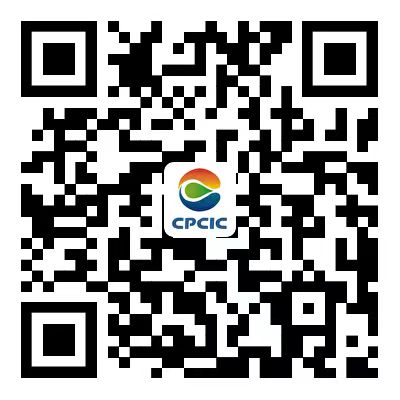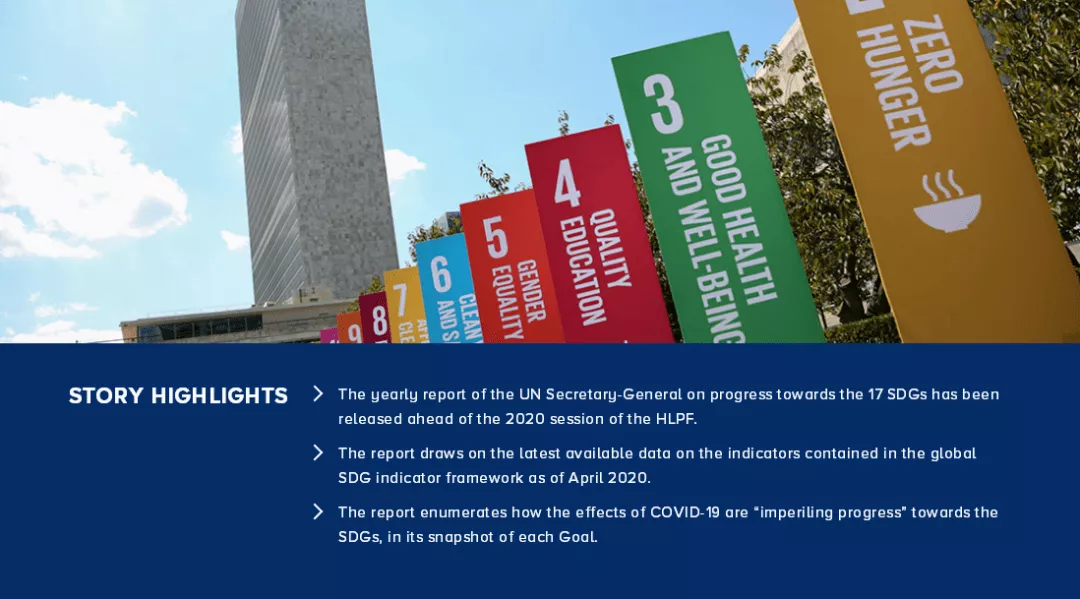载
大
会
官
方
A
P
P



总结,不仅仅是对过去的回顾,同样也隐藏着未来的趋势。
2020年已过半,各种揭示上半年经济、社会发展的各项数据也相继出炉。那么,很多朋友也很关注:在新冠疫情的影响下,2020年上半年,可持续发展的进展如何呢?在全球疫情仍不明朗的情况下,2020年下半年的可持续发展工作应该怎么开展呢?
近日,国际可持续发展研究院(IISD)发布了题为《联合国秘书长发布<2020年可持续发展目标进展报告>》(UN Secretary-General Releases 2020 SDG Progress Report)的报道,提出联合国秘书长关于17个可持续发展目标(SDG)的年度报告,并透露将在2020年高级别政治论坛之前发布。
报告利用了2020年4月之前SDG指标框架所包含的最新可用数据,列举了COVID-19疫情对SDG进展的影响。
本期“前沿双语”,我们分享给读者的就是该报告所揭示的可持续发展目标进展情况,相信在对上半年可持续发展推进的情况有了基本面的认识后,对于下半年更好的推进可持续发展和社会责任的工作,一定会有新的启示。

目标1:消除世界各地各种形式的贫困
COVID-19疫情之前,全球减排的步伐就在减缓,预计到2030年消除贫困的全球目标将无法实现。COVID-19疫情导致数千万人重新陷入极端贫困,这使多年的发展处于危机之中。尽管疫情期间着重强调需要加强社会保护和应急准备与响应,但这些措施不足以保护最需要保护的穷人和弱势群体。

目标2:消除饥饿,实现粮食安全和改善营养,促进可持续农业
自2015年以来,遭受严重粮食不安全困扰的人数总量不断增加,仍有数百万营养不良的儿童。疫情造成的经济减速和粮食价值链中断加剧了饥饿和粮食不安全。此外,东非和也门的沙漠蝗虫激增仍然令人震惊,那里已有3500万人遭受严重的粮食不安全状况。受COVID-19疫情的硬性影响,约有3.7亿小学生失去了他们赖以生存的免费学校餐。必须立即采取措施加强粮食生产和分配,以减轻和尽量减少受疫情的影响。

目标3:确保所有年龄段所有人的健康生活并促进福祉
许多卫生领域的进展仍在继续,但其改善速度已经放慢,不足以实现大多数SDG3的目标。COVID-19疫情正在破坏全球卫生系统,并威胁到已经取得的健康成果。大多数国家,特别是贫穷国家,没有足够的卫生设施、医疗用品和医护人员来应对激增的需求。各国需要综合的卫生战略并增加卫生系统支出,以满足紧急需要和保护卫生工作者,同时需要全球协调努力来支持有需要的国家。

目标4:确保包容性和公平的素质教育,并为所有人提供终身学习机会
截至2019年底,仍有数百万儿童和青年失学,其中一半以上的儿童没有达到最低阅读和计算能力标准。关闭学校以阻止COVID-19疫情扩散,这对儿童和青年的学习成绩以及社会和行为发展产生了不利影响,影响了全球90%以上的学生人口。即使向许多学生提供了远程学习,但生活在偏远地区、赤贫、脆弱国家和难民营等弱势环境中的儿童和青年却没有同样的机会。数字鸿沟将扩大现有的教育平等差距。

目标5:实现性别平等并赋予所有妇女和女孩权力
促进两性平等的承诺在某些领域带来了改善,但是,每个妇女和女孩都享有充分的性别平等,消除赋予她们权力的所有法律、社会和经济障碍这一承诺仍然没有实现。目前受疫情影响,也给妇女和女孩带来沉重打击。全球范围内,医生和护理人员人数的3/4为女性。妇女在家从事无偿照料工作的时间是男性的3倍。关闭学校和日托所需要父母,特别是妇女,更多地照顾孩子并促进他们在家学习。一些国家的报告表明,全球封锁期间,针对妇女和儿童的家庭暴力也在增加。

目标6:确保所有人用水和卫生设施的可用性和可持续管理
全球仍有数十亿人无法获得安全管理的水和卫生服务以及家中使用的基本洗手设施(WASH),这对于防止COVID-19疫情传播至关重要。立即采取行动改善WASH服务对于预防感染和遏制COVID-19疫情传播至关重要。

目标7:确保所有人获得负担得起、可靠、可持续和现代化的能源
世界在增加电力供应和提高能源效率方面取得了良好进展。然而,全球仍有数百万人无法获得电力,清洁烹饪燃料和技术的进展也很慢。COVID-19疫情凸显了对医疗中心提供可靠和负担得起的电力的需要。然而,在选定的发展中国家进行的一项调查显示,被调查的卫生设施中有1/4没有通电,还有1/4的计划外停电影响了他们提供基本卫生服务的能力。

目标8:促进持续、包容和可持续的经济增长、充分就业和生产性就业以及人人享有体面工作
即使在当前危机之前,尽管劳动生产率和失业率有所提高,但全球经济增长速度仍低于前几年。受COVID-19疫情的影响,更是破坏了全球经济,使世界陷入衰退。全球劳动力市场受到前所未有的冲击,预计将导致2020年第2季度总工作时间减少约10.5%,相当于3.05亿全职工人。中小型企业、非正规就业工人、自营职业者、日薪工人以及处于风险最高部门的工人受到的影响最大。

目标9:建设有弹性的基础设施,促进包容性和可持续工业化及创新
在COVID-19疫情之前,全球制造业增长就已经稳步下降。受到疫情影响,更是对制造业造成沉重打击,并导致全球价值链和产品供应中断。

目标10:减少国家内部和国家之间的不平等
尽管在某些方面出现了一些减少不平等现象的积极迹象,比如,一些国家减少了相对收入不平等,优惠贸易地位使低收入国家受益,但不平等现象仍然以各种形式存在。COVID-19危机正对最贫穷和最脆弱的人造成最严重打击,并有可能对最贫穷的国家产生严重影响。这暴露了国家内部和国家之间存在的严重不平等,并加剧了这些不平等。

目标11:使城市和人类住区具有包容性、安全性、弹性和可持续性
快速城市化正在导致贫民窟居民数量增加、基础设施和服务不足和负担过重,以及空气污染恶化。COVID-19疫情将对全球10亿以上的贫民窟居民造成最严重打击,这些人缺乏适当的住房、家中没有自来水、共用厕所、废物管理系统很少或根本没有、公共交通拥挤、无法获得正规卫生设施。其中许多人在非正规部门工作,随着城市限行,他们很有可能失去生计。

目标12:确保可持续消费和生产模式
全球消费和生产取决于自然环境和资源的利用,其模式继续对地球造成破坏性影响。COVID-19疫情为各国提供了制定恢复计划的机会,该计划将扭转当前趋势并改变我们的消费和生产方式,使其走向可持续的未来。

目标13:采取紧急行动应对气候变化及其影响
2019年是有记录以来第二热的年份,也是最热十年(2010-2019年)的结束。由于全球平均气温比工业化前估计的水平高出1.1°C,全球社会无法实现《巴黎协定》所要求的1.5°C或2°C目标。尽管预计到2020年温室气体排放量将下降6%,而且由于旅行禁令和COVID-19疫情导致的经济放缓,空气质量有所改善,但这种改善只是暂时的。各国政府和企业应吸取经验教训,以加快实现《巴黎协定》所需的转型,重新定义与环境的关系,并对低温室气体排放和具有气候适应力的经济体和社会进行系统性转型。

目标14:保护和可持续利用海洋与海洋资源促进可持续发展
海洋和渔业继续支持着全球人口的经济、社会和环境需求,同时承受着不可持续的消耗、环境恶化以及二氧化碳饱和与酸化。目前保护关键海洋环境、小型渔民和海洋科学投资的努力尚未满足保护这一庞大而脆弱的资源的迫切需求。

目标15:保护、恢复和促进陆地生态系统的可持续利用,可持续管理森林,防治荒漠化,制止和扭转土地退化,制止生物多样性丧失
森林面积继续减少,保护区没有集中在关键的生物多样性地区,物种仍然面临灭绝的威胁。然而,仍有一些努力正在引起人们注意并产生积极的影响,有助于扭转这些结果,如,在可持续森林管理方面,在陆地、淡水和山区保护区覆盖率方面以及在实施保护生物多样性和生态系统的方案、立法和会计原则方面都取得了进展。

目标16:促进和平和包容性社会促进可持续发展,为所有人提供诉诸司法的机会,并在各级建立有效、负责任和包容性的机构
冲突、不安全、体制薄弱和司法渠道有限仍然是对可持续发展的巨大威胁。数百万人被剥夺了安全、人权和伸张正义的机会。COVID-19疫情可能导致社会动荡和暴力的增加,这将极大地削弱我们实现可持续发展目标的能力。

目标17:加强执行手段,振兴全球可持续发展伙伴关系
由于资金短缺、贸易紧张、技术障碍和数据缺乏,加强全球伙伴关系和加强落实可持续发展目标的手段仍然具有挑战性。COVID-19继续蔓延给可持续发展目标的实施增加了更多困难,导致全球金融市场出现重大损失和震荡,超过1000亿美元的资本流出新兴市场,是有记录以来流出资金最多的一次。预计到2020年,全球贸易将暴跌13%~32%。加强多边主义和全球伙伴关系比以往任何时候都更加重要。
Goal 1. End poverty in all its forms everywhere
Even before the COVID-19 pandemic, the pace of global poverty reduction was decelerating and it had been projected that the global target of ending poverty by 2030 would be missed.The COVID-19 pandemic is pushing tens of millions of people back into extreme poverty,putting years of progress at risk. While the pandemic highlighted the need to strengthen social protection and emergency preparedness and response, these are insufficient to safeguard the poor and the vulnerable where they are most needed.
Goal 2. End hunger, achieve food security and improved nutrition and promote sustainable agriculture
The total number of people suffering from severe food insecurity is on the rise since 2015 and there are still millions of malnourished children. The economic slowdowns and disruptions in the food value chains caused by the pandemic is exacerbating hunger and food insecurity. In addition, the Desert Locust upsurge remains alarming in East Africa and Yemen where 35 million people already experience acute food insecurity. Due to the pandemic, some 370 million school children are missing the free school meals they rely on. Measures to strengthen food production and distribution systems must be taken immediately to mitigate and minimize the impacts of the pandemic.
Goal 3. Ensure healthy lives and promote well-being for all at all ages
Progress in many health areas continues, but the rate of improvement has slowed down and will not be sufficient to meet most of Goal 3 targets. The COVID-19 pandemic is devastating health systems globally and threatens already achieved health outcomes. Most countries,especially poor countries, have insufficient health facilities, medical supplies and health care workers for the surge in demand. Countries need comprehensive health strategies and increased health system spending to meet urgent needs and protect health workers, while a global coordinated effort is needed to support countries in need.
Goal 4. Ensure inclusive and equitable quality education and promote lifelong learning opportunities for all
At the end of 2019, millions of children and youth were still out of school and more than half of those in school were not meeting minimum proficiency standards in reading and numeracy.School closures to stop the spread of COVID-19 are having an adverse impact on learning outcomes and social and behavioral development of children and youth. They have affected over 90% of the world’s student population—1.6 billion children and youth. Even though remote learning is provided to many students, children and youth in vulnerable and disadvantaged communities, such as those living in remote areas, extreme poverty, fragile states and refugee camps, do not have the same access. The digital divide will widen existing education equality gaps.
Goal 5. Achieve gender equality and empower all women and girls
The commitments to advancing gender equality have brought about improvements in some areas, but the promise of a world in which every woman and girl enjoys full gender equality and all legal, social and economic barriers to their empowerment have been removed, remains unfulfilled. The current pandemic is also hitting women and girls hard. Globally, women make up three quarters of medical doctors and nursing personnel. Women already spend three times as many hours on unpaid care work at home as men. School and daycare closures require parents, especially women, to care more for children and facilitate their learning at home. Reports from several countries suggest that domestic violence against women and children is also rising during the global lockdown.
Goal 6. Ensure availability and sustainable management of water and sanitation for all
Billions of people around the world still lack access to safely managed water and sanitation services and to basic handwashing facilities (WASH) at home, critical to prevent COVID-19 spreading. Immediate action to improve WASH services is critical for preventing infection and containing the spread of the coronavirus.
Goal 7. Ensure access to affordable, reliable, sustainable and modern energy for all
The world is making good progress on increasing access to electricity and improving energy efficiency. However, still millions of people around the world lack access to electricity and progress on access to clean cooking fuels and technologies is too slow. The COVID-19 pandemic spotlights the need for reliable and affordable electricity to health centres. However, a survey conducted in selected developing countries showed that one quarter of the health facilities surveyed were not electrified and another quarter reported unscheduled outages affecting their capacity to deliver essential health services. All these facts further weaken the health system response to the current health crisis.
Goal 8. Promote sustained, inclusive and sustainable economic growth, full and productive employment and decent work for all
Even before the current crisis, the global economy was growing at a slower rate than in previous years, despite improvements in labour productivity and unemployment. The COVID-19 pandemic has abruptly and profoundly disrupted the global economy, pushing the world into a recession. The unprecedented shock to the world’s labour markets is expected to result in a drop of around 10.5% in aggregate working hours in the second quarter of 2020,equivalent to 305 million full-time workers. Small and medium enterprises, workers in informal employment, the self-employed, daily wage earners, and workers in sectors at highest risk of disruption are hit the hardest.
Goal 9. Build resilient infrastructure, promote inclusive and sustainable industrialization and foster innovation
The global manufacturing growth had already steadily declined even before the outbreak of the COVID-19 pandemic. The pandemic is hitting manufacturing industries hard and causing disruptions in global value chains and the supply of products.
Goal 10. Reduce inequality within and among countries
Despite some positive signs toward reducing inequality in some dimensions, such as reducing relative income inequality in some countries and preferential trade status benefiting lower income countries, inequality still persists in all forms. The COVID-19 crisis is hitting the poorest and most vulnerable people hardest and threatens to have a particularly damaging impact on the poorest countries. It is laying bare the profound inequalities that exist within and among countries and is exacerbating these inequalities.
Goal 11. Make cities and human settlements inclusive, safe, resilient and sustainable
Rapid urbanization is resulting in a growing number of slum dwellers, inadequate and overburdened infrastructure and services, and worsening air pollution. The COVID-19 pandemic will hit hardest the more than one billion slum dwellers worldwide, who suffer from a lack of adequate housing, no running water at home, shared toilets, little or no waste management systems, overcrowded public transport and limited access to formal health care facilities. Many of these populations work in the informal sector and are at high risk of losing their livelihoods as cities shut down. Urgent response plans are needed to prepare for and respond to outbreaks in informal settlements and slums.
Goal 12. Ensure sustainable consumption and production patterns
Worldwide consumption and production—a driving force of the global economy—rest on the use of the natural environment and resources in a model that continues to lead to destructive impacts on the planet. The COVID-19 pandemic offers countries an opportunity to build a recovery plan that will reverse current trends and change our consumption and production
patterns towards a sustainable future.
Goal 13. Take urgent action to combat climate change and its impacts
he year 2019 was the second warmest on record and the end of the warmest decade (2010-2019). In addition, with a global average temperature of 1.1°C above estimated pre-industrial levels, the global community is way off track to meeting either the 1.5°C or 2°C targets called for in the Paris Agreement. Although greenhouse gas emissions are projected to drop 6% in 2020 and air quality has improved due to travel bans and economic slowdown resulting from the COVID-19 pandemic, this improvement is only temporary. Governments and businesses should utilize the lessons learnt to accelerate transitions needed to achieve the Paris Agreement,re-define the relationship with the environment, and make systemic shifts and transformational changes to low-GHG emission and climate-resilient economies and societies.
Goal 14. Conserve and sustainably use the oceans, seas and marine resources forsustainable development
Oceans and fisheries continue to support the global population’s economic, social and environmental needs, while suffering unsustainable depletion, environmental deterioration and CO2 saturation and acidification. Current efforts to protect key marine environments,small-scale fishers and invest in ocean science are not yet meeting the urgent needs to protect this vast, fragile resource.
Goal 15. Protect, restore and promote sustainable use of terrestrial ecosystems, sustainably manage forests, combat desertification, and halt and reverse land degradation and halt biodiversity loss
Forest areas continue to decline, protected areas are not concentrated in areas of key biodiversity and species remain threatened with extinction. However, there are efforts gaining traction and having positive effects that can help to reverse these outcomes, such as increased progress towards sustainable forest management, gains in protected area coverage for terrestrial, freshwater and mountain areas, as well as progress in implementing programs,legislation and accounting principles to protect biodiversity and ecosystems.
Goal 16. Promote peaceful and inclusive societies for sustainable development, provide access to justice for all and build effective, accountable and inclusive institutions at all levels
Conflict, insecurity, weak institutions and limited access to justice remain a great threat to sustainable development. Millions of people have been deprived of their security, human rights and access to justice. In 2018, the number of people fleeing war, persecution and conflict exceeded 70 million, the highest level recorded by UNHCR in almost 70 years. The COVID-19 pandemic is potentially leading to an increase in social unrest and violence that would greatly undermine our ability to meet the targets of SDG 16.
Goal 17. Strengthen the means of implementation and revitalize the Global Partnership for Sustainable Development
Strengthening global partnerships and enhancing the means of implementation for the SDGs has remained challenging due to scarce financial resources, trade tensions, technological obstacles, and lack of data. The pandemic is adding more hardships in the implementation ofthe SDGs. As COVID-19 continues to spread, global financial markets have experienced great losses and intense volatility, as over $100 billion in capital has flowed out of emerging markets since the outbreak, the largest outflow ever recorded. World trade is expected to plunge between 13% and 32% in 2020. Strengthening multilateralism and global partnership are more important than ever before. The global nature of the pandemic requires the participation of all government, the private sector, civil society organizations and people around the world.
免责声明:本文章仅代表作者个人观点,与石化行业走出去联盟无关。其原创性以及文中陈述文字和内容未经联盟证实,对本文以及其中全部或者部分内容的真实性、完整性、及时性石化行业走出去联盟不作任何保证或承诺,请读者仅作参考,并请自行核实相关内容。
© 2025 CPCIC2025 www.cpcic.org All Rights Reserved.